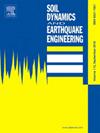利用创新型 SMA 高阻尼橡胶减震器控制连续地震下重新定位钢架的地震响应
IF 4.2
2区 工程技术
Q1 ENGINEERING, GEOLOGICAL
引用次数: 0
摘要
本研究开发了一种新型自定心高阻尼橡胶减振器(SMA-HRD),其中包含形状记忆合金(SMA)丝绳。对传统的高阻尼橡胶减振器(HRD)和 SMA 组件进行了设计和测试,并评估了它们在不同加载频率下的机械性能。建立了装有该阻尼器的自定心功能钢架的有限元模型,以进行主余震序列下的地震时程分析。结果表明,随着加载频率的增加,HRD 的滞后曲线变得更加饱满。同样,SMA-HRD 的滞后曲线也随着加载频率的增加而变得饱满,由于加入了 SMA 丝绳,其复位效果非常明显。对主余震序列的位移时程分析表明,普通钢架在主震发生 20 秒后仍有无法恢复的变形,为后续余震创造了不利的初始条件,加剧了结构的进一步破坏。在罕见的地震条件下,普通钢框架的层间漂移峰值和残余漂移量都超过了抗震规范规定的限值。自定心节点框架的最大层间漂移角也超过了这些临界值。然而,装有 SMA-HRD 和 SMA-HRD 复合自定心节点框架的框架则表现出更优越的抗震性能。值得注意的是,SMA-HRD 显著降低了自定心节点框架的层间位移峰值,显示了其增强抗震能力的潜力。本文章由计算机程序翻译,如有差异,请以英文原文为准。
Seismic response control of recentering steel frame with innovative SMA-high damping rubber dampers under sequential earthquakes
In this study, a novel self-centering high-damping rubber damper (SMA-HRD), incorporating shape memory alloy (SMA) filament ropes, was developed. Both the conventional high-damping rubber damper (HRD) and the SMA components were designed and tested, with an assessment of their mechanical properties across various loading frequencies. A finite element model of a self-centering functional steel frame equipped with this damper was established to perform seismic time-course analysis under the main aftershock sequence. The results indicated that the hysteresis curve of the HRD becomes fuller as the loading frequency increases. Similarly, the hysteresis curve of the SMA-HRD also becomes fuller with increasing loading frequency, and the resetting effect is pronounced due to the inclusion of the SMA filament rope. Displacement time-history analysis of the main aftershock sequence showed that an ordinary steel frame still had unrecoverable deformation 20 s after the mainshock, creating unfavorable initial conditions for the subsequent aftershock and exacerbating further damage to the structure. Under rare earthquake conditions, the peak and residual interstory drift of ordinary steel frames surpassed the limits set by seismic codes. The maximum interstory drift angle of self-centering nodal frames also surpassed these thresholds. However, frames equipped with SMA-HRD and SMA-HRD composite self-centering nodal frames demonstrated superior seismic performance. Notably, the SMA-HRD significantly reduced the peak interstory displacement in the self-centering nodal frames, demonstrating its potential to enhance seismic resilience.
求助全文
通过发布文献求助,成功后即可免费获取论文全文。
去求助
来源期刊

Soil Dynamics and Earthquake Engineering
工程技术-地球科学综合
CiteScore
7.50
自引率
15.00%
发文量
446
审稿时长
8 months
期刊介绍:
The journal aims to encourage and enhance the role of mechanics and other disciplines as they relate to earthquake engineering by providing opportunities for the publication of the work of applied mathematicians, engineers and other applied scientists involved in solving problems closely related to the field of earthquake engineering and geotechnical earthquake engineering.
Emphasis is placed on new concepts and techniques, but case histories will also be published if they enhance the presentation and understanding of new technical concepts.
 求助内容:
求助内容: 应助结果提醒方式:
应助结果提醒方式:


